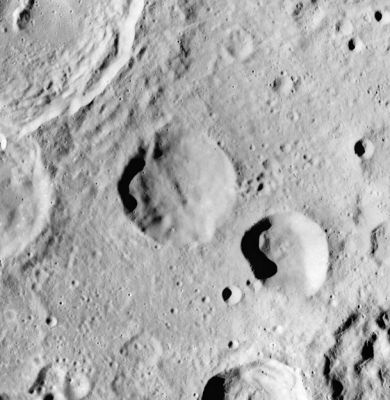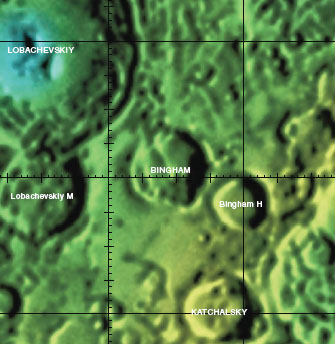Difference between revisions of "Bingham"
(Created page with "<div id="content_view" class="wiki" style="display: block"> =Bingham= {| class="wiki_table" | Lat: 8.1°N, Long: 115.1°E, Diam: 33 km, Depth: km, Rükl: ''(farside)''<br /...") |
|||
| (3 intermediate revisions by the same user not shown) | |||
| Line 5: | Line 5: | ||
|- | |- | ||
| | | | ||
| − | [http://lpod.org/coppermine/displayimage.php?pid=4176&fullsize=1 [[Image: | + | [http://lpod.org/coppermine/displayimage.php?pid=4176&fullsize=1 [[Image:Normal_bingham-large.jpg|external image normal_bingham-large.jpg]]]<br /> |
| | | | ||
| − | [[Image: | + | [[Image:Bingham-color.jpg|bingham-color.jpg]]<br /> |
|} | |} | ||
| − | <br /> '''Left''' [http://apollo.sese.asu.edu/data/metric/AS16/png/AS16-M-2871_SML.png AS16-M-2871] from [http://apollo.sese.asu.edu/browse/thumbnails.php?mission=AS16&cam=metric&all=1 Apollo Image Archive]. '''Right''' [http://planetarynames.wr.usgs.gov/images/Lunar/lac_65.pdf Color-coded LAC 65] from the [ | + | <br /> '''Left''' [http://apollo.sese.asu.edu/data/metric/AS16/png/AS16-M-2871_SML.png AS16-M-2871] from [http://apollo.sese.asu.edu/browse/thumbnails.php?mission=AS16&cam=metric&all=1 Apollo Image Archive]. '''Right''' [http://planetarynames.wr.usgs.gov/images/Lunar/lac_65.pdf Color-coded LAC 65] from the [[USGS%20Digital%20Atlas|USGS Digital Atlas]]<br /> <div id="toc"> |
| − | + | ||
| − | |||
==Images== | ==Images== | ||
[http://www.lpod.org/coppermine/thumbnails.php?album=search&type=full&search=Bingham LPOD Photo Gallery] [http://www.lpi.usra.edu/resources/lunar_orbiter/bin/srch_nam.shtml?Bingham%7C0 Lunar Orbiter Images] [http://www.lpi.usra.edu/resources/apollo/search/feature/?feature=Bingham Apollo Images]<br /> - '''Bingham''' on six of Apollo 16's panoramic ''ITEK''-camera frames:<br /> [http://www.lpi.usra.edu/resources/apollo/frame/?AS16-P-5016 AS16-P-5016] and [http://www.lpi.usra.edu/resources/apollo/frame/?AS16-P-5021 5021] show '''Bingham''''s western part. To see '''Bingham''', scroll to the right toward the location between the centres and right margins of all six frames.<br /> [http://www.lpi.usra.edu/resources/apollo/frame/?AS16-P-5014 AS16-P-5014] and [http://www.lpi.usra.edu/resources/apollo/frame/?AS16-P-5019 5019] show '''Bingham''''s central part.<br /> [http://www.lpi.usra.edu/resources/apollo/frame/?AS16-P-5012 AS16-P-5012] and [http://www.lpi.usra.edu/resources/apollo/frame/?AS16-P-5017 5017] show '''Bingham''''s eastern part.<br /> - Research: Danny Caes<br /> <br /> | [http://www.lpod.org/coppermine/thumbnails.php?album=search&type=full&search=Bingham LPOD Photo Gallery] [http://www.lpi.usra.edu/resources/lunar_orbiter/bin/srch_nam.shtml?Bingham%7C0 Lunar Orbiter Images] [http://www.lpi.usra.edu/resources/apollo/search/feature/?feature=Bingham Apollo Images]<br /> - '''Bingham''' on six of Apollo 16's panoramic ''ITEK''-camera frames:<br /> [http://www.lpi.usra.edu/resources/apollo/frame/?AS16-P-5016 AS16-P-5016] and [http://www.lpi.usra.edu/resources/apollo/frame/?AS16-P-5021 5021] show '''Bingham''''s western part. To see '''Bingham''', scroll to the right toward the location between the centres and right margins of all six frames.<br /> [http://www.lpi.usra.edu/resources/apollo/frame/?AS16-P-5014 AS16-P-5014] and [http://www.lpi.usra.edu/resources/apollo/frame/?AS16-P-5019 5019] show '''Bingham''''s central part.<br /> [http://www.lpi.usra.edu/resources/apollo/frame/?AS16-P-5012 AS16-P-5012] and [http://www.lpi.usra.edu/resources/apollo/frame/?AS16-P-5017 5017] show '''Bingham''''s eastern part.<br /> - Research: Danny Caes<br /> <br /> | ||
==Maps== | ==Maps== | ||
| − | ''([ | + | ''([[LAC%20zone|LAC zone]] 65A3)'' [http://www.lpi.usra.edu/resources/mapcatalog/LTO/lto65a3_1/ LTO map]<br /> <br /> |
==Description== | ==Description== | ||
| − | On first look at '''Bingham''' one would think that crater is a very old one. With a rim that is smooth all around, and an unlevelled, shallow-looking floor that is, virually, non-exiatant, the crater appearance suggest's it's been through the mill in most of the Moon's history. However, the nearby 84-kilometre-sized crater, [ | + | On first look at '''Bingham''' one would think that crater is a very old one. With a rim that is smooth all around, and an unlevelled, shallow-looking floor that is, virually, non-exiatant, the crater appearance suggest's it's been through the mill in most of the Moon's history. However, the nearby 84-kilometre-sized crater, [[Lobachevskiy|Lobachevskiy]], some 30 kilometres to its north-west, may be the culprit as to why '''Bingham''' looks the way it does. Ejecta from '''Lobachevskiy''' more than likely covered over any semblence of sharp-ish features it once had, as it fell on the crater's rim and floor -- whose lumpy-looking appearance is due possibly to blocks of that same material landing inside. Tens of small craters lie both inside the crater as well as on its rim, however, their appearance at high-resolution shows them to hve smooth-looking rims just like '''Bingham''' does. Are these craters due to smaller fragments of '''Lobachevskiy's''' ejecta falling on the initial ejecta material aftewards? <span class="membersnap">- JohnMoore2</span><br /> <br /> |
==Description: Wikipedia== | ==Description: Wikipedia== | ||
[http://en.wikipedia.org/wiki/Bingham_(crater) Bingham]<br /> <br /> | [http://en.wikipedia.org/wiki/Bingham_(crater) Bingham]<br /> <br /> | ||
| Line 29: | Line 28: | ||
<br /> <br /> | <br /> <br /> | ||
---- | ---- | ||
| − | + | </div> | |
Latest revision as of 20:02, 16 April 2018
Contents
Bingham
| Lat: 8.1°N, Long: 115.1°E, Diam: 33 km, Depth: km, Rükl: (farside) | |
Left AS16-M-2871 from Apollo Image Archive. Right Color-coded LAC 65 from the USGS Digital Atlas
Images
LPOD Photo Gallery Lunar Orbiter Images Apollo Images
- Bingham on six of Apollo 16's panoramic ITEK-camera frames:
AS16-P-5016 and 5021 show Bingham's western part. To see Bingham, scroll to the right toward the location between the centres and right margins of all six frames.
AS16-P-5014 and 5019 show Bingham's central part.
AS16-P-5012 and 5017 show Bingham's eastern part.
- Research: Danny Caes
Maps
Description
On first look at Bingham one would think that crater is a very old one. With a rim that is smooth all around, and an unlevelled, shallow-looking floor that is, virually, non-exiatant, the crater appearance suggest's it's been through the mill in most of the Moon's history. However, the nearby 84-kilometre-sized crater, Lobachevskiy, some 30 kilometres to its north-west, may be the culprit as to why Bingham looks the way it does. Ejecta from Lobachevskiy more than likely covered over any semblence of sharp-ish features it once had, as it fell on the crater's rim and floor -- whose lumpy-looking appearance is due possibly to blocks of that same material landing inside. Tens of small craters lie both inside the crater as well as on its rim, however, their appearance at high-resolution shows them to hve smooth-looking rims just like Bingham does. Are these craters due to smaller fragments of Lobachevskiy's ejecta falling on the initial ejecta material aftewards? - JohnMoore2
Description: Wikipedia
Additional Information
Nomenclature
Hiram Bingham III (November 19, 1875 June 6, 1956) was an American academic, explorer and politician. He rediscovered the Inca settlement of Machu Picchu in 1911. On July 24, 1911, Melchor Arteaga led Bingham to Machu Picchu, which had been largely forgotten by everybody except the small number of people living in the immediate valley. Bingham has been cited as one possible basis for the 'Indiana Jones' character.
LPOD Articles
Bibliography

